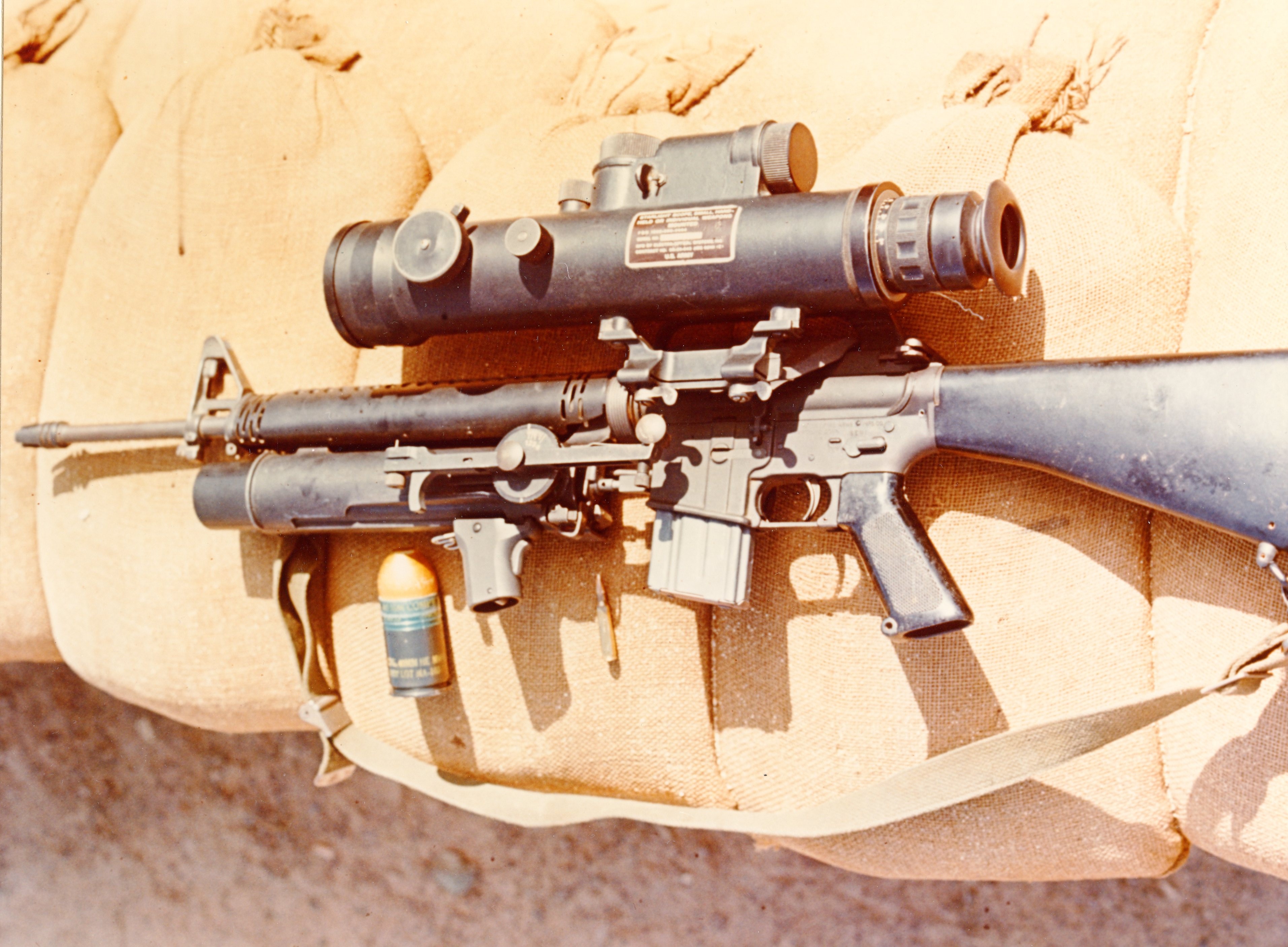M16A1: Difference between revisions
Skizmophonic (talk | contribs) No edit summary |
Skizmophonic (talk | contribs) No edit summary |
||
| (8 intermediate revisions by the same user not shown) | |||
| Line 1: | Line 1: | ||
[[Category:Weapons]] | |||
[[Category:Weapons of Vietnam]] | |||
{| class="wikitable sortable" style="margin:auto;text-align: center;width:90%" | {| class="wikitable sortable" style="margin:auto;text-align: center;width:90%" | ||
|- | |- | ||
| Line 7: | Line 9: | ||
! rowspan=2 | [[Ammo]] | ! rowspan=2 | [[Ammo]] | ||
|- | |- | ||
|[[File:Flag_us_new.png|50px]]<br><strong>[[US]]</strong>|| [[File:M16a1.png|512px]]<br><b> [[M16A1]]</b> || [[File:Weapon m16a1.svg|512px]] || [[File:Class_Assault.png|50px]] <b>[[Assault]]<br> || 20 / 60 | |[[File:Flag_us_new.png|50px]]<br><strong>[[US]]</strong>|| [[File:M16a1.png|512px]]<br><b> [[M16A1]]</b> || [[File:Weapon m16a1.svg|512px]] || [[File:Class_Assault.png|50px]] <b>[[Assault]]<br> || 20[[+1]] / 60 | ||
|- | |- | ||
|} | |} | ||
| Line 20: | Line 22: | ||
! rowspan=2 | [[Bayonet]] | ! rowspan=2 | [[Bayonet]] | ||
! rowspan=2 | [[Rifle Grenades]] | ! rowspan=2 | [[Rifle Grenades]] | ||
! colspan=2 | Reload Speed | |||
|- | |- | ||
|37||×2.5 = 92.5||×1.2 = 44.4||×1.15 = 42.55||×0.8 = 29.6||×0.75 = 27.75||YES||NO | ! Partial!! Empty | ||
|- | |||
|37||×2.5 = 92.5||×1.2 = 44.4||×1.15 = 42.55||×0.8 = 29.6||×0.75 = 27.75||YES||NO||2.366 Seconds||3.166 Seconds | |||
|- | |- | ||
|} | |} | ||
| Line 46: | Line 51: | ||
! rowspan=2 | [[Place of Origin]] | ! rowspan=2 | [[Place of Origin]] | ||
! rowspan=2 | [[Date]] | ! rowspan=2 | [[Date]] | ||
! rowspan=2 | [[ | ! rowspan=2 | [[Manufacturer]] | ||
! rowspan=2 | Barrel Length | ! rowspan=2 | Barrel Length | ||
! rowspan=2 | Total Length | ! rowspan=2 | Total Length | ||
! rowspan=2 | [[Weapon Script Name]] | ! rowspan=2 | [[Weapon Script Name]] | ||
|- | |- | ||
|Rifle, Caliber 5.56 mm, M16A1||5.56mm||[[USA]]||1959||Colt and Many Other||20 in (508 mm)||38.81 in (986 mm)||weapon_m16a1 | |Rifle, Caliber 5.56 mm, M16A1||[[5.56mm]]||[[USA]]||1959||Colt and Many Other||20 in (508 mm)||38.81 in (986 mm)||weapon_m16a1 | ||
|- | |- | ||
|} | |} | ||
| Line 59: | Line 64: | ||
In 1964, the M16 entered US military service and in the following year was deployed for jungle warfare operations during the Vietnam War. In 1969, the M16A1 replaced the [[M14]] rifle to become the US military's standard service rifle. The M16A1 incorporated numerous modifications including a bolt-assist, chrome-plated bore, protective reinforcement around the magazine release, and revised flash hider. | In 1964, the M16 entered US military service and in the following year was deployed for jungle warfare operations during the Vietnam War. In 1969, the M16A1 replaced the [[M14]] rifle to become the US military's standard service rifle. The M16A1 incorporated numerous modifications including a bolt-assist, chrome-plated bore, protective reinforcement around the magazine release, and revised flash hider. | ||
=HISTORY= | =HISTORY= | ||
In 1928, the U.S. Army recommended transitioning to smaller caliber rounds, like the .27 in (6.86 mm) caliber, but tradition kept the .30 in (7.62 mm) caliber in use. Post-WWII, the military sought a new automatic rifle, leading to the [[M14]]'s development, which was found to be uncontrollable in full-auto and outclassed by the [[AK-47]] in Vietnam. This prompted a reevaluation of a lighter, intermediate caliber rifle, leading to the [[AR-15]]'s development, which fired the .223 inch (5.56 mm) round. Despite initial Army resistance, Secretary of Defense Robert McNamara halted M14 production in favor of the AR-15, later standardized as the M16. | In 1928, the U.S. Army recommended transitioning to smaller caliber rounds, like the .27 in (6.86 mm) caliber, but tradition kept the .30 in (7.62 mm) caliber in use. Post-WWII, the military sought a new automatic rifle, leading to the [[M14]]'s development, which was found to be uncontrollable in full-auto and outclassed by the [[AK-47]] in Vietnam. This prompted a reevaluation of a lighter, intermediate caliber rifle, leading to the [[AR-15]]'s development, which fired the .223 inch ([[5.56 mm]]) round. Despite initial Army resistance, Secretary of Defense Robert McNamara halted M14 production in favor of the AR-15, later standardized as the M16. | ||
The M16, lighter than the M14, faced reliability issues in Vietnam due to inadequate maintenance instructions and cleaning kits, and an incorrect powder switch. These problems were addressed with the M16A1's introduction, which included a chrome-plated chamber and better maintenance protocols. The M16 eventually gained acceptance and became the longest-serving rifle in U.S. military history, setting a standard for assault rifles worldwide. | The M16, lighter than the M14, faced reliability issues in Vietnam due to inadequate maintenance instructions and cleaning kits, and an incorrect powder switch. These problems were addressed with the M16A1's introduction, which included a chrome-plated chamber and better maintenance protocols. The M16 eventually gained acceptance and became the longest-serving rifle in U.S. military history, setting a standard for assault rifles worldwide. | ||
| Line 72: | Line 77: | ||
File:USIA 64-116.jpg | File:USIA 64-116.jpg | ||
File:111-ccv-570-cc44322-1.jpg | File:111-ccv-570-cc44322-1.jpg | ||
File:XM16-XM148-Starlight-AFB-Vietnam339.jpg|M16 with XM148 grenade launcher and Starlight scope | File:XM16-XM148-Starlight-AFB-Vietnam339.jpg|M16 with a [[XM148]] grenade launcher and Starlight scope | ||
</gallery> | </gallery> | ||
| Line 100: | Line 105: | ||
service=youtube | service=youtube | ||
|id=https://www.youtube.com/watch?v=bsCIuihpHDE | |id=https://www.youtube.com/watch?v=bsCIuihpHDE | ||
|alignment=inline | |||
}} | |||
{{#evt: | |||
service=youtube | |||
|id=https://www.youtube.com/watch?v=yh2FGCYC63Q | |||
|alignment=inline | |alignment=inline | ||
}} | }} | ||
Latest revision as of 07:08, 5 November 2024
| Factions | Weapon | Icon | Classes | Ammo |
|---|---|---|---|---|
 US |
 M16A1 |
 |
 Assault Assault |
20+1 / 60 |
| Damage Base | Headshot × | Chest × | Stomach × | Leg × | Arm × | Bayonet | Rifle Grenades | Reload Speed | |
|---|---|---|---|---|---|---|---|---|---|
| Partial | Empty | ||||||||
| 37 | ×2.5 = 92.5 | ×1.2 = 44.4 | ×1.15 = 42.55 | ×0.8 = 29.6 | ×0.75 = 27.75 | YES | NO | 2.366 Seconds | 3.166 Seconds |
| Designation | Weapon Type | Fire Modes | Fire Rate | Bullet Spread ° | Range Modifier | Muzzle Velocity | Projectile weight | Weight |
|---|---|---|---|---|---|---|---|---|
| M16A1 | Assault Rifle | Auto+Semi | 750 RPM | 7.17° & 1.15° ADS | 0.955 | 960 m/s | 12.3 g (189.818 gr) | 2.89 kg (6.37 lbs) |
| Full name | Caliber | Place of Origin | Date | Manufacturer | Barrel Length | Total Length | Weapon Script Name |
|---|---|---|---|---|---|---|---|
| Rifle, Caliber 5.56 mm, M16A1 | 5.56mm | USA | 1959 | Colt and Many Other | 20 in (508 mm) | 38.81 in (986 mm) | weapon_m16a1 |
The M16 is a family of military rifles originally developed by Eugene Stoner in the late 1950s adapted from the ArmaLite AR-15 rifle for the U.S. military.
In 1964, the M16 entered US military service and in the following year was deployed for jungle warfare operations during the Vietnam War. In 1969, the M16A1 replaced the M14 rifle to become the US military's standard service rifle. The M16A1 incorporated numerous modifications including a bolt-assist, chrome-plated bore, protective reinforcement around the magazine release, and revised flash hider.
HISTORY
In 1928, the U.S. Army recommended transitioning to smaller caliber rounds, like the .27 in (6.86 mm) caliber, but tradition kept the .30 in (7.62 mm) caliber in use. Post-WWII, the military sought a new automatic rifle, leading to the M14's development, which was found to be uncontrollable in full-auto and outclassed by the AK-47 in Vietnam. This prompted a reevaluation of a lighter, intermediate caliber rifle, leading to the AR-15's development, which fired the .223 inch (5.56 mm) round. Despite initial Army resistance, Secretary of Defense Robert McNamara halted M14 production in favor of the AR-15, later standardized as the M16.
The M16, lighter than the M14, faced reliability issues in Vietnam due to inadequate maintenance instructions and cleaning kits, and an incorrect powder switch. These problems were addressed with the M16A1's introduction, which included a chrome-plated chamber and better maintenance protocols. The M16 eventually gained acceptance and became the longest-serving rifle in U.S. military history, setting a standard for assault rifles worldwide.
You can read the m16a1 Operation guide here
M16 with a XM148 grenade launcher and Starlight scope



